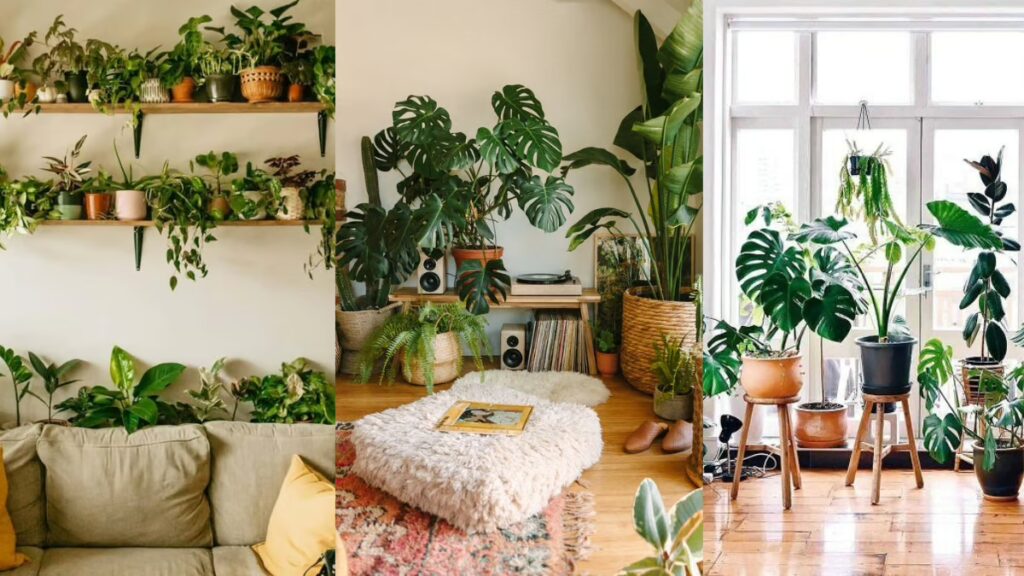Indoor air quality has a profound impact on our well-being, and what better way to purify your space than with nature’s own air filters? Houseplants not only remove toxins from the air but also add a touch of greenery, making your home feel fresh and inviting. In this article, we’ll explore the top houseplants that purify air and tips to incorporate them into your living space.
Why Choose Houseplants for Air Purification?

Table of Contents
Houseplants are more than just decor—they play a vital role in improving indoor air quality. Many plants are known to absorb toxins such as benzene, formaldehyde, and carbon monoxide while releasing oxygen. NASA’s Clean Air Study even highlights the efficacy of houseplants in reducing indoor air pollutants. Alongside their purifying properties, these plants also:
- Boost humidity levels.
- Improve mental health and focus.
- Create a natural, calming environment.
Top Houseplants That Purify Air
Here’s a detailed look at some of the best air-purifying houseplants to enhance your home’s atmosphere.
- Snake Plant (Sansevieria)
- Features: One of the most effective air purifiers; absorbs toxins like formaldehyde and nitrogen oxide.
- Care Tips: Low-maintenance; thrives in indirect light and requires minimal watering.
- Peace Lily (Spathiphyllum)
- Features: Known for removing ammonia, benzene, and trichloroethylene.
- Care Tips: Prefers shady spots; keep soil moist but not soggy.
- Spider Plant (Chlorophytum comosum)
- Features: Excellent for removing carbon monoxide and toxins like formaldehyde.
- Care Tips: Tolerates neglect; thrives in indirect sunlight and well-drained soil.
- Aloe Vera
- Features: Purifies air while offering a natural remedy for skin irritations.
- Care Tips: Requires bright, indirect sunlight and occasional watering.
- Areca Palm (Dypsis lutescens)
- Features: Adds moisture to the air, ideal for dry environments.
- Care Tips: Thrives in bright, indirect sunlight; keep soil consistently moist.
- Boston Fern (Nephrolepis exaltata)
- Features: Removes pollutants like formaldehyde and xylene.
- Care Tips: Requires high humidity and indirect light.
Best Practices for Maintaining Air-Purifying Houseplants
To ensure your plants thrive and effectively purify the air:
- Placement: Position plants in rooms where you spend the most time, such as bedrooms or living rooms.
- Lighting: Match plants to the lighting conditions of your space (e.g., low light for Snake Plants, bright light for Aloe Vera).
- Watering: Avoid overwatering; let the topsoil dry out before watering again.
- Cleaning: Wipe leaves regularly to prevent dust buildup, which can hinder their air-purifying ability.
How to Style Your Home with Air-Purifying Plants

Incorporating air-purifying plants can be both functional and stylish:
- Living Room: Use larger plants like Areca Palm in decorative pots to create a focal point.
- Bedroom: Place Peace Lilies on nightstands for clean, breathable air while you sleep.
- Office: Add a Snake Plant to your desk for better focus and productivity.
- Hanging Plants: Spider Plants work beautifully in hanging baskets, saving floor space.
FAQs About Top Houseplants That Purify Air
1. What are the best houseplants for air purification?
Some of the best houseplants for air purification include Snake Plant, Peace Lily, Spider Plant, Aloe Vera, and Areca Palm. These plants are known for their ability to remove toxins from the air and improve indoor air quality.
2. How do houseplants purify air?
Houseplants purify air through a process called phytoremediation. They absorb harmful toxins like benzene, formaldehyde, and carbon monoxide through their leaves and roots, converting them into harmless substances.
3. Do air-purifying plants work in small spaces?
Yes, air-purifying plants work effectively in small spaces. Even one or two plants like a Snake Plant or Peace Lily can improve air quality in compact areas such as bedrooms or offices.
4. Which houseplants are low-maintenance and purify air?
Snake Plant and Spider Plant are excellent low-maintenance options. They thrive in a variety of conditions, require minimal watering, and still effectively purify the air.
5. Are air-purifying plants safe for pets?
Some air-purifying plants, like Spider Plants, are pet-friendly. However, others like Peace Lilies and Aloe Vera can be toxic to pets. Always check plant toxicity before introducing them to a home with pets.
6. How many air-purifying plants should I have in a room?
NASA recommends having at least one plant per 100 square feet for optimal air purification. However, even a few plants can make a noticeable difference in smaller spaces.
7. Do air-purifying plants need sunlight to work?
Yes, most air-purifying plants require some light to thrive and perform their air-cleaning functions. However, plants like Snake Plant and Peace Lily can tolerate low light conditions.
8. Can air-purifying plants improve sleep quality?
Yes, plants like Peace Lily and Snake Plant release oxygen and absorb toxins, creating a cleaner sleeping environment that can improve sleep quality.
9. How do I care for air-purifying plants?
- Ensure they are placed in suitable lighting conditions.
- Water them only when needed to avoid overwatering.
- Wipe the leaves to remove dust and maximize air purification.
10. Where can I buy air-purifying houseplants?

Air-purifying houseplants are available at local nurseries, garden centers, and online plant stores. Always look for healthy plants with no signs of pests or diseases.
Conclusion
Transform your home into a natural oasis with these top houseplants that purify air. From improving air quality to uplifting your mood, these plants are an effortless way to create a healthier, more inviting space. Start small with one or two plants and watch your home come to life.
For more gardening tips and ideas, visit GardenLoom and discover how to create your own green sanctuary!









